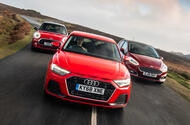Why Are Hatchbacks and Superminis Still the Top Choice for Used Car Buyers?
If you’ve been browsing the used car market lately, you might have noticed something surprising: while SUVs and crossovers seem to rule the roads when it comes to new car sales, it’s the humble hatchbacks and superminis that dominate the second-hand charts. In fact, nine out of the ten best-selling used cars in the UK are still these compact, practical models. So, what’s driving this trend, and why do so many buyers stick with these smaller cars even as the new car market shifts toward bigger, bolder SUVs?
Let’s dig into what’s really going on—and what it means if you’re thinking about your next car.
What’s Behind the Shift from Hatchbacks to SUVs in New Car Sales?
Over the past decade, the new car landscape has changed dramatically. Back in 2015, the top sellers were almost all hatchbacks and superminis—think Ford Fiesta, Vauxhall Corsa, and Ford Focus. Only a couple of crossovers, like the Vauxhall Mokka and Nissan Qashqai, cracked the top ten.
Fast forward to 2025, and it’s a different story. SUVs now make up eight of the ten best-selling new cars in the UK. Models like the Ford Puma and Kia Sportage are leading the charge, while only the Vauxhall Corsa and Volkswagen Golf keep the hatchback flag flying in the top ten.
Why the change? It’s partly down to what manufacturers want to sell. SUVs and crossovers offer higher profit margins, and with tougher safety and emissions regulations squeezing the bottom line, many carmakers have scaled back or even discontinued their smaller models. The Ford Fiesta, for example, was withdrawn from sale in 2023 despite being a long-time favourite.
Why Do Used Car Buyers Still Favour Smaller Cars?
Here’s where things get interesting. Despite the SUV boom in new car sales, the used market tells a different story. Hatchbacks and superminis remain the go-to choice for second-hand buyers, with the Ford Fiesta topping the charts for the first half of 2025. The only SUV to break into the top ten? The Nissan Qashqai.
So, what’s keeping these smaller cars in such high demand? For starters, there are still a lot of them on the road. Even after Ford stopped making the Fiesta, nearly 1.4 million were registered in the UK at the end of last year—making it the nation’s most common car.
But it’s not just about availability. Superminis and hatchbacks are practical, affordable, and economical to run. They’re easy to park, cheap to insure, and perfect for city driving or short commutes. For many buyers—especially those looking for value in a cost-of-living crisis—these qualities matter more than the latest styling or tech.
How Do Residual Values Stack Up Between Hatchbacks and SUVs?
Let’s talk numbers. You might assume that SUVs, being newer and more in demand, would hold their value better. Not necessarily.
Take the Ford Fiesta and Ford Puma as examples. A three-year-old Fiesta with 30,000 miles in Titanium trim is currently worth around £11,500. The equivalent Puma fetches about £13,500. But here’s the kicker: the Fiesta cost £18,655 new in 2022, while the Puma was £24,940. That means the Fiesta’s depreciation rate is 38%, compared to 46% for the Puma.
In plain English? The Fiesta loses less of its value over three years than the Puma does. For used car buyers, that’s a big deal—it means you’re getting more car for your money, and you’re less likely to take a hit if you sell it on in a few years.
Are Used Car Sales Really Bouncing Back After the Pandemic?
Absolutely. According to the latest data from the Society of Motor Manufacturers and Traders (SMMT), second-hand car sales in the UK topped four million units in the first half of the year—the highest figure since before the pandemic. By contrast, new car sales still haven’t fully recovered to pre-Covid levels.
Mike Hawes, CEO of the SMMT, summed it up: the used car market is regaining momentum, but for this to continue, the new car market needs to stay healthy too. It’s a delicate balance—today’s new cars are tomorrow’s used cars, after all.
What’s Happening with Used Electric Vehicles and Hybrids?
No conversation about the car market is complete without mentioning electric vehicles (EVs). Between April and June, used EV sales shot up by 40% year-on-year, reaching nearly 69,000 units and making up 3.4% of the used market. Tesla’s Model 3 led the pack.
Hybrids and plug-in hybrids (PHEVs) are also gaining ground, with sales up 27.7% and 10.3% respectively. The growth is impressive, but it’s still early days—most used car buyers are sticking with petrol and diesel for now, mainly due to concerns about charging infrastructure and upfront costs.
That said, as more new EVs hit the market and filter down into the used sector, expect these numbers to keep climbing. Incentives like the Electric Car Grant are helping, but the real tipping point will come when used EVs are as affordable and practical as their petrol-powered counterparts.
What Does This Mean for You as a Used Car Buyer?
If you’re shopping for a used car, the message is clear: hatchbacks and superminis still offer unbeatable value, especially if you’re looking for something reliable, economical, and easy to live with. Models like the Ford Fiesta, Vauxhall Corsa, and Volkswagen Golf remain top picks for good reason—they’re everywhere, parts are cheap, and they hold their value surprisingly well.
But don’t ignore the growing options in the used EV and hybrid market. Prices are coming down, and as the infrastructure improves, these cars will become an increasingly smart choice for more drivers.
The bottom line? The used car market is more diverse and dynamic than ever. Whether you’re after a tried-and-true hatchback or ready to make the leap to electric, there’s never been a better time to find a car that fits your life—and your budget.

